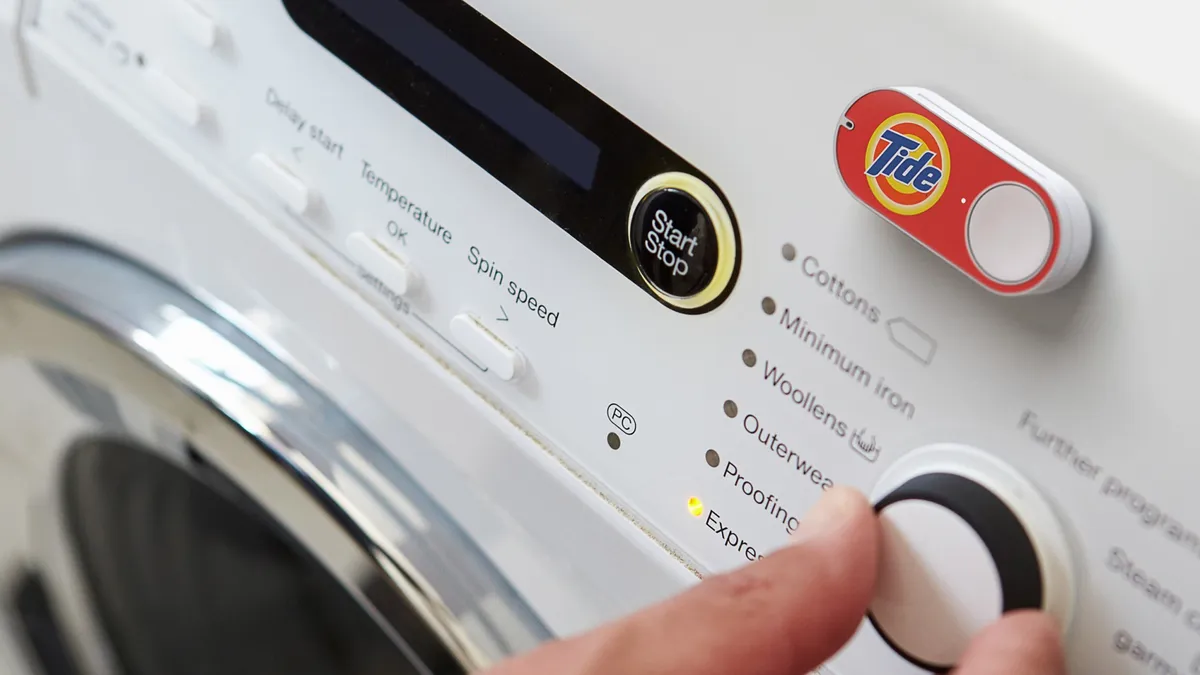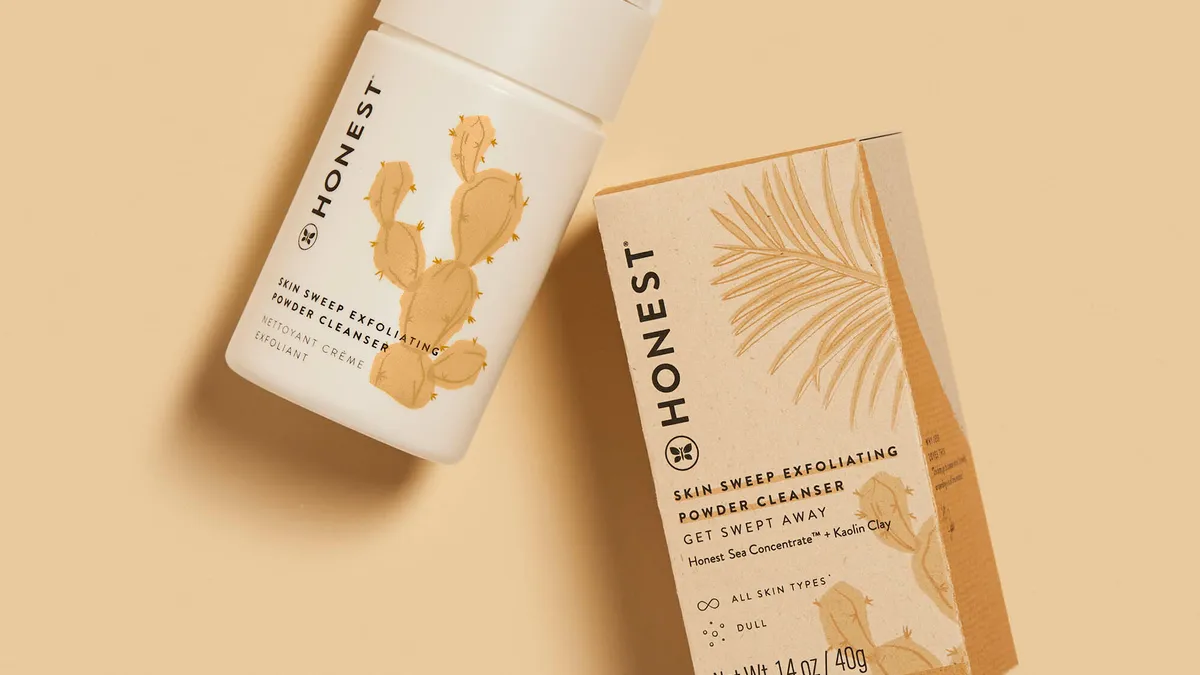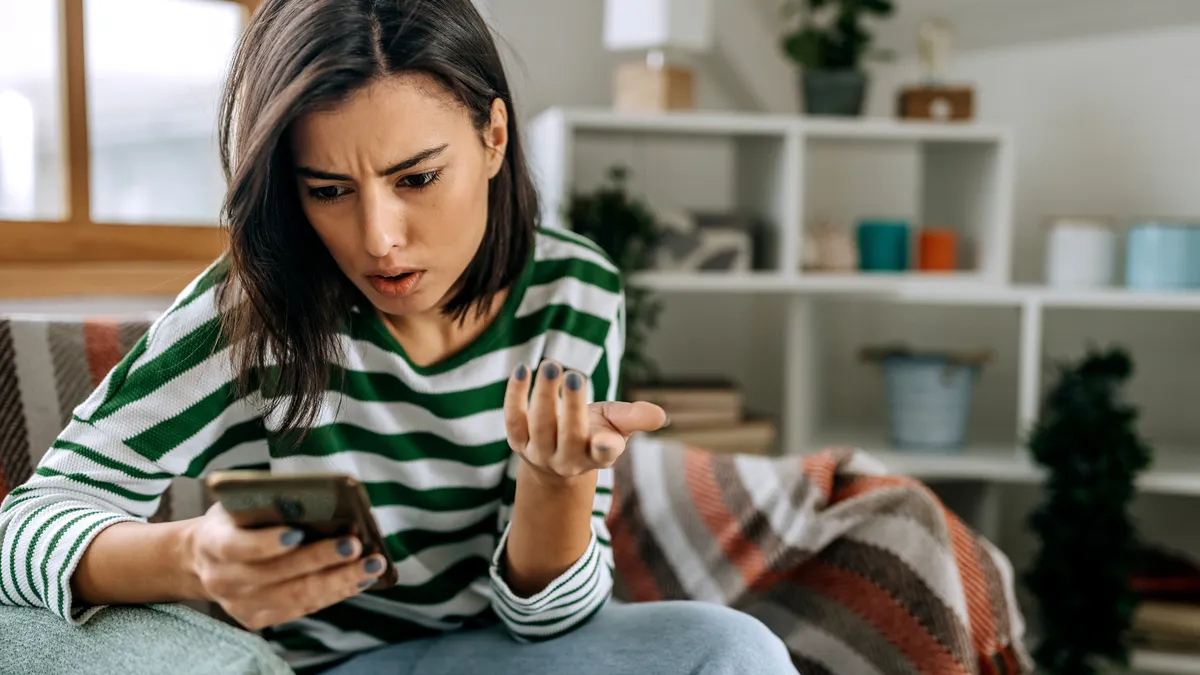Most weeks find Amazon garnering quite a bit of attention for one thing or another. But Amazon’s Dash button, announced last week, was truly a surprise. The button, available to Prime members for now on an invitation-only basis, allows reorders of household items with a simple touch.
The buttons, which are meant to be adhered to appliances or walls, work only for a certain number of brands. The “Internet of Things”-ish setup is designed to make it a no-brainer for items like toilet paper and laundry detergent that consumers run out of and replenish without browsing. A lot of news stories even took pains to point out that Dash is real — it was introduced very close to April Fool’s Day — and the New Yorker went so far as to call it a “horror.”
But what does this new Amazon gizmo mean for retail? Retail Dive talked to some experts to find out.
Solving a 'real need'?
The Amazon Dash button is designed to make it easier to replenish items that you regularly buy right when or just before you run out. They’ve even anticipated that your kids may want to prank you and press the button a million times — the order will only go in once no matter how many times it's pressed, and allow for reorders only when the package has been delivered. Super-convenient, right?
But how inconvenient was that to start with? Not very, Jerry Jao, CEO and founder of marketing firm Retention Science, told Retail Dive.
“It’s not like it’s that much work to order detergent,” Jao says. “Amazon has already done a really great job of making that easy. I question whether they’re really solving a real need.”
In fact, the problem that Amazon has solved may actually be its own. With the Dash button, Amazon has eliminated a gap, the time between needing something to getting it, creating, says Anil Kaul, CEO of Absolutdata, a “Zero Moment of Purchase.”
“Just as Google summarized internet-driven decision making as the ‘Zero Moment of Truth,’ Amazon has created the ‘Zero Moment of Purchase,’ putting brands at the exact moment of need,” Kaul told Retail Dive. “In a Zero Moment of Purchase scenario, all other factors – coupons, packaging, advertising – become irrelevant.”
That’s more like Amazon’s approach to its Fire phone, a device designed to make things better for Amazon rather than for consumers. But the phone has pretty much flopped. The buzz about the button is real, but that may be the extent of it, in an era when an app may have done the trick, says Jeff Fagel, CMO of marketing company G/O Digital.
“The premise and problem that Amazon Dash is intended to solve comes down to ease and convenience,” Fagel told Retail Dive.
“Making it easy, and in the case of Amazon, simplicity of user experience, one-tap-and done. Anything that adds work on the consumer side, from opt-in to turning on their location settings, sounds good on paper," Fagel says. "But today's mobile consumer quickly tires of novelty that requires effort. Why do I need Amazon Dash when I already have the Amazon app on my smartphone? Is it making my life easier or simply making my house more cluttered with plastic buttons?”
Overestimating brand loyalty
The Amazon Dash button for Tide detergent may be excellent for someone who never questions his or her choice of Tide or doesn’t want or need to shop around for the best price. But Jao says that today’s consumer is more open to shifting brands than that, and that the Dash button actually interferes with consumers’ own sense of power. That gap that Kaul describes may not be something that consumers want to close.
“I think consumers have a tendency to change preferences, it’s like eating cereal,” Jao says. “ How do I change my preferences when there’s only one button?”
Jao says he can't help but respect the Dash's innovation and Amazon's general knack for getting everyone to talk about its latest move, but says this one is unlikely to stick, at least not how it is now, out of the gate.
"I do respect Amazon’s ability to launch new initiatives," he says. "I think they’re a little off with this particular idea. I think it could potentially be refined, depending on how much these buttons cost to make. Maybe have a button with four quadrants so that you can also order other things, [like] drier sheets; have it part of that routine in the laundry room. I can see that there may be room for more great innovation. But then again, how many buttons do we need?"
Underestimating brick-and-mortar
Jeff Bezos may be used to being underestimated; it happens time and time again. But this time, he may have underestimated consumers’ appreciation of physical retail stores, says Fagel. Something, of course, that physical stores should be capitalizing on.
“While Amazon can ship items anywhere, it still doesn’t deliver on the promise of immediacy and local physical store relevancy,” Fagel says. “That tactile experience of being inside a retail store – seeing and touching products – is not going away anytime soon.”
Plus, there are times when a product is needed immediately, and no gap-closing can eliminate that, Fagel says.
“There are moments of distress and inspiration where Jeff Bezos can't win. Currently Amazon can’t win versus Walgreens or CVS with distress purchases — ‘The kids are sick’ or ‘We’re out of diapers,’” he says. “Physical stores are national retailers’ best defense to differentiate against Amazon. Amazon can ship from everywhere, but can it fulfill the local needs?”
No more channels
Amazon’s Dash button may not be the ultimate threat to retailers, but its innovative stance still is, our experts said.
“From drones to the Dash button, Jeff Bezos and Amazon are adept at getting headlines, but the value for customers is questionable,” Fagel says. “Amazon Fresh is a bigger threat to physical retailers, Walmart, Target, and grocery stores. If Amazon can deliver on solving same day, instant gratification across their entire inventory of products, that is a major threat to all retailers, big or small.”
The advantage for brick-and-mortar retailers is, in fact, not just the physical store, but the all-channel system that having a physical presence can bring. Bagel says that means blurring the lines between channels to the point where they’re not felt by the consumer.
“Retailers have to do what Amazon can't do — be channel-less,” Fagel says.























